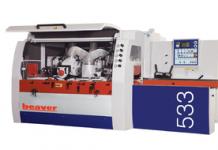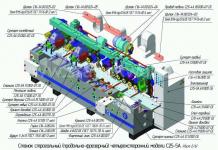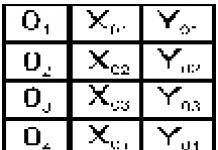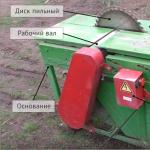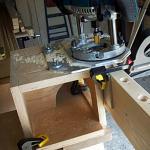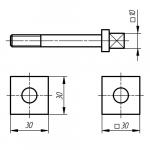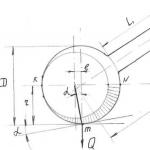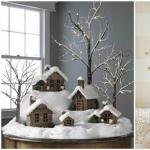Multi-spindle machines are very efficient in saving time when processing wood in large volumes.
Wooden blanks, after sawing, have defects, such as surface unevenness, cracks, etc., which must be eliminated before proceeding with their further processing.
To eliminate these defects, milling machines are used, through which each of the four surfaces of the workpiece is processed separately.
When the volume of wood being processed is large enough, it is easier, more convenient and more economical to use multi-spindle woodworking machines.
Such machines are also called. As the name suggests, all four planes of the workpiece are machined, or gouged, simultaneously.
It can have from 4 to 10 spindles, depending on the requirements for the final type of your product. Simply put, the number of spindles depends on the complexity of the profile of the product that you want to obtain at the output of the machine.
consists of the following main parts:
- Working and serving tables;- Feed and eject rollers;
- Lower and upper spindles;
- Right and left spindles;
- Additional spindles for creating complex profile shapes;
- Universal spindle.
The feeding table has clamping elements and the ability to adjust the frame vertically, which allows you to pass workpieces of various thicknesses through the machine.
For example, in order to smooth a heavily deformed surface, it is necessary to remove a large amount of wood; on the other hand, straight wood preparation requires the removal of a very small layer of material (it is enough to remove only band saw marks).
In a situation where it is necessary to straighten a piece of wood entering the machine, a pressure roller is used, located in front of the first upper spindle. An additional pressure block located in front of the first lower spindle is used for thin material that does not need straightening. This option can be disabled via the machine control panel.
At the initial stage of the material passing through, it is very important to achieve smoothness on the bottom and right sides of the workpiece, which are the basis for further operations to give the desired shape to your product.
Another method of straightening wood, using a grooved table, is most suitable for processing hard wood. In this case, the first lower cutting block forms grooves on the underside of the workpiece, shaped like the pattern of a grooved table, which reduces friction between the workpiece and the tabletop and evenly feeds the material for further processing.
But this method of straightening wood requires the four-sided machine to have another lower spindle, the cutting unit of which will remove the intermediate grooves and level the lower surface of the product. The work table can be equipped with a manual or automatic feeding system for waxilite, a resin-dissolving lubricant, to facilitate feeding of the workpiece. In the case of processing resinous wood, the presence of an additional lower spindle is also necessary to remove waxilite from the underside of the workpiece.
Feed rollers of four-sided planer
Feed rollers can be equipped with spring or pneumatic cylinders. The rollers must be properly designed to provide maximum traction and minimum wear.
Vertical spindles of four-sided planer:
Vertical spindles require a high-quality and flexible adjustment system, otherwise, changing the type of profile and, accordingly, the diameter of the tool will take a lot of time.
Quick adjustment of the vertical spindles allows for optimal contact between the workpiece and the work table.
When the vertical spindles of the four-sided planer are in a clearly fixed position, the diameter and working height of the cutting tool, as well as the feed speed and pressure of the feed rollers are adjusted simultaneously through the digital control panel. High-quality adjustment of the left vertical spindle guarantees high quality gouging, and is especially important when working with hard wood.
Top spindle of four-sided planer
The top spindle is the first right vertical spindle of the machine. The cutting tool located at the top position can be used both for planing the surface and for profiling the workpiece. A good four-sided machine should produce up to 40 mm of profiling on the top horizontal/vertical spindle.
Universal Spindle for Four Side Planer
The planer can be equipped with an additional universal spindle to achieve greater profiling flexibility.
Four Side Planer Options
The four-sided planer can be equipped with additional optional devices, such as: an additional feed device after the upper horizontal spindle, a grooved work table for processing hardwood, extended feed and work tables, increased power of spindle motors and others.
One of the important indicators of modern woodworking machines is the productivity and quality of the work that is performed on it. Equipment that meets both requirements is a four-sided machine. The design feature of such mechanisms is that they can perform several operations simultaneously, while the wood is processed from four sides at once.
Components and functionality
The main functions that a four-sided planer can perform are jointing, milling and planing. Thanks to the special design machine, finishing and roughing can be performed simultaneously.
The main components of the model are:
- workpiece feed unit;
- spindle section;
- Control block.
In this case, there can be several processing heads. Thanks to this approach to layout, operating time is optimized and the cost of finished products is reduced.
Before you start working on a four-sided machine, you need to understand how certain settings affect the device. Be sure to pay attention to how performance changes after tuning the processing units.
All devices of woodworking machines are divided into two types - four-sided longitudinal milling machines and thickness planers. Using the first option, you can cut the tree into pieces of a certain length. Also, such equipment can profile. Depending on the thickness of the workpiece being processed, the lower shaft of the knife moves up and down along with the tabletop of the device.
A thicknesser four-sided machine is used to process wood to a certain thickness on both sides at once. Since this equipment is initially planing, it can also profile.
If you process wood from four sides at once, you can significantly reduce the time spent, which usually requires much more than processing on any other device. And since operating time decreases, productivity, on the contrary, increases. This is why the four-sided woodworking machine is often used in construction and furniture production.
Advantages and disadvantages
One of the undeniable advantages of a four-sided machine is high productivity. To achieve optimal results, the design is equipped with a program control unit. A conventional machine can process bars with a quadrangular and circular cross-section. Sheet materials can be milled or jointed on one or both sides.
The main advantages of four-sided machines include the following:

Unfortunately, this is not to say that they have no shortcomings. They exist, and the main one is the high price. You will have to pay a lot to purchase such equipment. In addition, such a machine is difficult to set up.
However, high performance compensates for all these shortcomings.
In order to make the work automated, the device must be equipped with a line for automatically feeding wood for processing. Thanks to this block, the position of the workpiece relative to the tools that process it can also be changed.
Features of work
When using a four-sided wood saw, you must follow the rules specified in the instructions. Parts cannot be processed if their length or thickness exceeds those required by the rules. It is necessary to carry out preventive maintenance in a timely manner to maintain the normal condition of the machine.
The work will have maximum efficiency only if if you follow the following operating rules:

When adjusting the device to the required thickness, the supports of the upper foot head and upper rollers should be adjusted in height using flywheels. Screws help install the pressure rollers. To adjust the width, side clamps and a vertical spindle are used. You can adjust the machine to the desired profile by installing profile knives on the heads.
Setting up a four-sided machine takes place in six stages:

Self-production
Since the price of a woodworking machine is quite high, and not everyone can purchase one, many people prefer to save on their purchase. To make such equipment at home, you do not have to be a professional.
The step-by-step procedure for making a four-sided machine with your own hands is as follows:

A four-sided woodworking machine will help you efficiently process a wooden block or cylinder without a lot of time. The only serious drawback of such equipment is the high price. But even this can be eliminated if you make the machine yourself.
Hello, in this article we would like to introduce you to a home-made four-sided woodworking machine for home-made lining, floorboards, and indeed for planing any timber, moreover, the device operates from a simple 220-volt household outlet. Why? , and having seen enough on YouTube of all kinds of self-made woodworking equipment - they say, we also have such a “miracle unit”, maybe someone will be interested and useful this information for making something similar with their own hands. The master who made it, due to his youth (there was no power-tool Cambrian explosion then like now), was a professional machine operator and had the opportunity to make jointers, cutters, units and pulleys in production, so if someone does not know the mechanics of planing wood and the safe design of mechanisms, then , it is better not to undertake the manufacture of such devices! Not to mention safety precautions when working on woodworking machines, knowledge of the process of setting up a quadrilateral and its repair.
Training in straightening alloy wheels Selecting a tire changing machine Selecting a wheel straightening stand


By and large, the machine was assembled from what was at hand: a U-shaped channel, an angle and sheet metal. The device turned out to be stationary and heavy, but you can move it manually with two people. The allowance of the lower movable jointer is set semi-stationary, the feed table is bolted to the frame through spacers in the form of rings, and accordingly the thickness of the spacers is adjusted. Set to remove approximately 3mm. The upper jointer is movable and is adjusted to the thickness of the required timber from the receiving table. On both sides of the planing jointer there are movable (in height and width) pressure rollers. Next come two milling movable heads, equipped with both upper and side spring clamps. The right side clamping bars are also adjustable, but they are usually adjusted at a time, and further adjustment occurs with the upper jointer and the left milling cutter “for consumption”. For this four-sided machine, only electric motors (Belarusian, 2000 rpm, capacitor, 4 pcs.), knives, wires and bags were purchased. From the motor to the shaft, with its own belt tensioning system. A circular saw was made for the machine on a frame, with two saws on a shaft, for cutting unedged boards and a sharpening machine for knives, which is discussed below in order.
Cutters:
Planers and cutters, the most difficult part when building a machine, were made independently, in production, on universal metalworking machines. They were made of raw metal, presumably 20-30 steel, there were pigs lying around at the lathe - that’s what they were made from. I had experience working as an adjuster for a factory quadrilateral in production, and the principle of the entire design was removed from it, adjusted for the simplified possibility of manufacturing units. The jointer has a working length of 220 mm, a diameter equal to the workpiece, for three knives and different designs for their fastening. The first lower jointer is made according to the principle - a clamping bolt through the body, like on a factory unit, where they are generally aluminum, and are made on CNC machines. The jointer worked, but was difficult to manufacture, and such a design requires factory production. The bolts should not have heads, but should have an internal hexagon inside the thread diameter itself - and hardened. It was not possible to find such ones and I had to make a compromise by installing raw hex bolts with trimmed heads (pictured).



When manufacturing the second upper jointer, we had to abandon this design and resort to the classic scheme for fastening the knives: a bolt (hardened) through a clamping bar, with the head pressed into the body of the jointer. But with this design, it was necessary to mill an exact conical groove and a conical counter clamping plate. In the first (lower) jointer, the grooves are straight, without a cone. When milling the grooves on the second jointer, the finger cutter was pulled out of the collet, the width of the groove was not damaged, but it was deeply buried inside and spoiled a lot of work, chips, emulsion, large passages - the jamb is shorter. A very good welder saved the situation by miraculously welding the bottom of the groove. Fortunately, the product was still in allowance at this stage. The ball bearings in the brackets are pressed into grooves from the edges of the jointer, like a crankshaft in a motor. Essentially, three jointers were made, then one was cut into three cutters, with an internal diameter boring for the milling heads.
All planing corners and grooves, before processing, were drawn on the end of the workpiece from a stencil using a scriber. Planers and cutters were not balanced. The upper (second) jointer turned out better, it works smoother and makes less noise.
Machine for sharpening jointer knives 220v:
There is a machine and cutters, we need to somehow sharpen the knives on them, let’s continue to get weird, we’ll make a sharpening machine with our own hands. To do this, we need one linear movement relative to the abrasive thin wheel. Moreover, the alignment of the pressure bar and the stone does not matter. We sharpen by running the knife along the bar several times and bringing the bar, adjustable in the corners, to the emery wheel with screws. The removal at one time is not large, just a couple of sparks. When buying knives, make sure that they are straight, not curved after heat treatment (heating), otherwise you will have to press them firmly along the bar, removing the bend. Accordingly, the cutting edge of the knife will turn out to be curved, although this is not critical, they will plane, they will press on the jointer, the main thing is that their edges are in the same radius. In the photo there is a sharpener with two threads on the edges of the stop bar, but it can be made simpler: on the left is a loop, and on the right is a swivel threaded connection for supply. After sharpening, you can polish the edge on felt. You can sharpen any knives: a plane, a chisel, or any style. It is worth noting that there is a difference between knife and knife, good knives are difficult to find, go to all the tool stores, and there won’t be any standing there.



Circular saw with two cutters 220v:
We have a machine, sharp knives, now we need to cut the edges of the edged board. We are building a super circular, since there is such a booze. It is needed for running a large cubic capacity, or trimming poles into small beams up to 80/80mm. If there are small things, it is easier to cut with a hand-held circular saw. The electric motor is the same as on the four-sided machine, but on the saw frame it is possible to install a second motor in a sequential belt connection. That is, the first one turns the second pulley, the second pulley turns the shaft with the saws. The belt tension is dynamic, i.e. We start the motors without load at idle, then gradually transfer rotation to the shaft. It unwinds and then spins more by inertia. When the rotation speed drops, the capacitors turn on. The first cutter is stationary, the second cutter moves on the shaft by mounting on a double-sided collet. At the exit there are adjustable receiving bars. The teeth of the cutters are set as far apart as possible so as not to bite. You can cut a half-inch into cubes all day, it cuts straight along the length of the board, but the cut is rough.
Well, conclusion, advantages and disadvantages:
There is no automatic feed) Sometimes threads break, so you need one mating part to be hardened, either a bolt or a nut. Throughout the machine. Bearings get hot and fail, but within reasonable limits. Sockets and plugs melt), so you need to use models with a tight connection and in a ceramic case, turning off all unnecessary electrical appliances in the house. Use an electrical extension cord only with a high-ampere cord. After work, be sure to check all working electrical wiring. Difficult starting when cold: either at idle, with sequential belt tension, or with manually turning the belt when starting. At the same time, it is possible to run only three motors with a small allowance; they planed the lining on three sides to make 3/1.8 panels for pouring the foundation. As a rule, at the beginning as a surface planer, then as a router. There is no exhaust), during operation compressed air is supplied to blow chips. It rusts), paint it, don’t paint it, it still rusts without the factory anti-corrosion coating, the cutters are in diesel fuel, the machine is lubricated before long-term storage and stands under an awning. In general, this unit was built for building a house; it planed everything:
 lining, timber, floorboard, block house - for myself, now for the most part it stands and works under our orders for work, the client buys lumber ready-made, but there are situations when you need to make wooden jambs for doors in a log house or under a window, for installation in They had ready-made doors or windows, and for this there is an unedged floorboard, they threw it into the gazelle, brought a cut and planed blank: a board or timber. Now the upper tower with the jointer has been removed from the four sides and installed on the table in the workshop, like a surface planer with an upper jointer.
lining, timber, floorboard, block house - for myself, now for the most part it stands and works under our orders for work, the client buys lumber ready-made, but there are situations when you need to make wooden jambs for doors in a log house or under a window, for installation in They had ready-made doors or windows, and for this there is an unedged floorboard, they threw it into the gazelle, brought a cut and planed blank: a board or timber. Now the upper tower with the jointer has been removed from the four sides and installed on the table in the workshop, like a surface planer with an upper jointer.
Thank you for your attention!
In order to buy a four-sided machine for molded products, you need to decide on the type of product being manufactured. If you want to buy a machine for lining, then the basic four-sided machine for euro-lining is the five-spindle four-sided Beaver machine. Four-sided machines for wood and MDF are necessary equipment for almost every woodworking industry.
The price of a four-sided lathe may vary because the four-sided machine for wood comes in four-spindle, five-spindle, six-spindle, seven-spindle and multi-spindle. Depending on the client’s task, the required number of spindles is selected: a 4-spindle machine is suitable for calibrating bars, opening defects, and small carpentry tasks. A 4-spindle lining machine can be used in most cases, but it is better to buy a 5-spindle or 6-spindle quadrilateral.
There are different technologies for the production of lining and other moldings, but a four-sided machine will be used everywhere. And if the client has a large production volume, it is worth buying a high-speed four-sided machine. A high-speed four-sided machine is in demand in the production of floorboards, linings, blockhouses, and imitation timber and must be equipped with a jointer and counter supports and have a feed speed of 60 m/min. Jointer in a four-sided machine is a prerequisite for the production of high quality moldings. When you want to buy a high-speed four-sided woodworking machine, you need to purchase additional mechanization for four-sided woodworking machines or an automatic workpiece feeding system.
The beam machine is a heavy and complex piece of equipment. Therefore, if you do not want to buy a four-sided REX or WACO, you should give preference to Beaver machines for profiled and laminated timber with a 1-year warranty. Equipment for the production and manufacture of moldings must comply with GOST. Therefore, Beaver and Quadro machines are the best four-sided machine in terms of price-quality ratio.
Buy a four-sided woodworking machine at a competitive price
How to select and buy a four-sided machine from Beaver, Leadermac, Quadro, QCM, Westwood, Ostermann, Haskovo? Specialists from the KAMI association will advise you. They will also help you compare v-hold planing and molding machines and Borovichi for lining and other moldings, which have nothing in common with the famous Beaver brand. If you want to buy a Winner or Weinig machine, including a used one, then you can choose any four-sided machine from the Beaver or QUADRO line.
You can ask additional questions about 4-sided woodworking machines and get help in choosing equipment by contacting our specialists at the specified phone number.
Improvement of technological processes complicates the equipment and increases the productivity of an individual unit. In carpentry, the four-sided wood lathe combined previously separate operations on one table with a single pass of the workpiece. Cleanliness and precision of processing meets established quality standards.
Possible processing methods
Various heads with blades of different profiles can cut the layer from 4 sides of the blank:
- milling Performs only longitudinal cutting of wood under the groove. A disk-type cutter performs the task of cutting the board. To do this, clamps for the outgoing strips are placed on the receiving side of the table;
- planing;
- jointer
Most industrial models combine several types of cutting simultaneously. Round and square material is processed. Thin sheets of material undergo 2-sided milling and jointing.
Design specifics
The design of a four-sided woodworking machine includes 3 main parts:
- workpiece feeding device;
- spindle section with cutting elements;
- system for setting operating parameters, adjustment, control.
There are models that have several cutting mechanisms installed sequentially along one side of the part (multiple processing).
The types of this equipment are divided into 2 groups, each of which is represented by a variety of options:
- portable (mobile) type. Such four-sided machines are common in home and small repair shops. Automation, power, product range are limited, but make it possible to make wooden parts quickly in any conditions;
- stationary. They are used in established production to produce large volumes of timber, lining, lamellas, slats. Equipped with CNC, a set of various replaceable cutting elements. Process various types of raw materials of different sizes. Such milling machines require training of operating personnel due to the complexity of control, configuration, and maintenance.
In addition to 4-sided industrial equipment, private households use home-made woodworking equipment.
Feeding device
Adjusting the thickness of the removed chips on a four-sided machine is done by vertically shifting the front part of the table.
The wood is supplied by drive rollers (4 pcs). Fixation in the direction of movement - top, side clamps. Upper clamps and rollers perform their role due to weight (own, additional) or spring amplifiers.
The boards are fed into the 4-sided machine continuously, without a gap between the ends of subsequent units. The rupture requires new filling of raw materials into the rollers, which significantly extends the time for manufacturing products and increases labor costs.
Increased productivity is achieved by installing automated feed lines. They combine the functions of movement and positioning of the board. Feeding occurs at a speed of 8 – 22 m/min. In the latest serial developments implemented in Russia, rollers accelerate the wood feed to 100 m/min.

The speed of the knife shafts is 5000-6000 per minute. In machines of the latest designs, knife shafts are made up to 9000 rpm.
Processing area
The basic setup includes 2 horizontal shafts (top/bottom) and 2 vertical spindles. A head with a straight or shaped knife is placed on the spindle. The shaft rotation is in the range of 5000 - 9000 rpm.
The specified dimensions of the product are set by corresponding horizontal movement of the spindle, seating/raising of the cutting edge, and tilting the longitudinal axis at an angle of up to 25°. The thickness of the board is set by moving the upper shaft vertically.

The assembly layout may include the installation of a 5th planing shaft in order to obtain a profile along the bottom plane of the part.
Additionally, ironing knives are designed to eliminate waves on the surface of the wood from rotating heads. A block of fixed blades located at an angle of 45° to the table plane removes 0.02 -0.2 mm of wood with each edge. The wave crests from the jointer are cut to a specified cleanliness.
Control
Reducing human influence in the mechanical woodworking process increases its functions for accurate measurement, calculation of parameters for software, control of each phase of equipment operation, and the urgent need to correct deviations.
The control points are:
- calculation of the speed of movement of raw materials to maintain the specified processing accuracy;
- placing each individual node in calculated coordinates;
- synchronization of the complex operation;
- cleaning, removal of generated waste.
In individual production this requires a significant investment of time. In continuous production, it provides a significant gain in productivity and standardization of the quality of finished wood products.
Specialization
Installations for multilateral wood processing are complex enough in design to make one universal unit. Woodworking shops use varieties that are sufficient to quickly and accurately produce a certain range of products.
Having chosen a four-sided machine for profiling the timber, they produce a profile with a groove-tenon connection, two even (semicircular) sides. The planing operation can be combined on one machine after cutting the profile. The variety of beam cross-section geometry options is determined by the configuration of cutting attachments.
A carpenter using a four-sided longitudinal milling machine simplifies the work of producing wooden beams for door and window frames, baseboards, cabinet parts, and flooring.
Lumber after a circular saw has a poor surface quality. At the same time, a four-sided planing machine with the required performance allows you to achieve the required dimensional accuracy. It has from 4 to 10 spindles, on which, if necessary, a knife with a grooved blade for wood is placed. This makes it possible to operate the equipment as a machine for the production of profiled timber, based on production tasks.
Choice
Technical characteristics, electrical circuit, operating modes, equipment, programming - all this must be studied according to the manufacturer’s declared data. Features of automation operation, requirements for personnel qualifications, raw materials, and maintenance must be taken into account when organizing the production process and drawing up technological maps. Availability of service for a four-sided milling machine and spare parts for it will affect uninterrupted operation.
